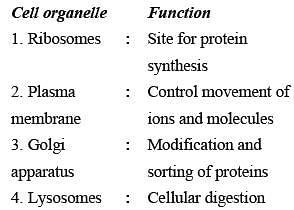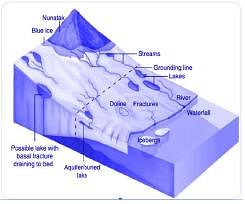UPSC CSE Complete Practice Test - 7 - UPSC MCQ
30 Questions MCQ Test Mock Test for UPSC Prelims 2025 - UPSC CSE Complete Practice Test - 7
Consider the following pairs with respect to cell organelles and their functions:

How many of the above pairs are correctly matched?

How many of the above pairs are correctly matched?
With reference to Green Budgeting, consider the following statements:
- It means using the tools of budgetary policy-making to help achieve environmental goals.
- It requires environmental impact assessments to accompany new budget measures.
- The Paris Collaborative, a multidisciplinary platform for research and analysis on Green Budgeting is convened by G20.
Which of the above statements is/are correct?
| 1 Crore+ students have signed up on EduRev. Have you? Download the App |
Which of the following statements best describes the term ‘Nunataks’?
Consider the following statements:
- Gender Budget is a separate budget for women that include women specific schemes.
- The gender Budget Statement was first introduced in India during the Union Budget 2020-2021.
Which of the above statements is/are correct?
Consider the following statements with reference to the Panchayat Development Index:
- The Panchayat Development Index (PDI) is a single dedicated domain on Governance and Administration of the panchayats.
- It aims to enhance the overall well-being and quality of life of rural communities.
Which of the statements given above are correct?
Consider the following statements: :
1. Kosalas were ruling Magadha when Alexander invaded India.
2. Battle of the Hydaspes was fought between Alexander and King Ambhi of Taxila.
3. Porus along with King Ambhi, defeated Alexendar and ended his Indian conquest.
How many of the statements given above are incorrect?
From 2016, RBI introduced a new methodology for calculation of the Base Rates based on marginal cost of funds rather than average cost of funds. This methodology is based on which of the following factors:
- Average Cost of deposits/funds
- Cost of maintaining CRR and SLR
- Operational Costs of Banks
- Return/profit on Net worth (investment)
- Tenor Premium (based on the time period for which loan is given)
Select the correct answers using the codes below:
Consider the following statements regarding the Grievance Redressal Assessment and Index (GRAI) 2022:
- It was conceptualised and designed by the Department of Administrative Reforms and Public Grievances.
- It is aiming at organization-wise comparison to identify strengths and areas for improving grievance redressal.
Which of the above statements is/are incorrect?
Consider the following statements regarding the Writs and their uses:
Statement-I: The writs play a crucial role in safeguarding the fundamental rights and liberties of individuals.
Statement-II: They are enshrined in Articles 32 and 226 of the Indian Constitution.
Which one of the following is correct in respect of the above statements?
Consider the following statements regarding transgenic crops in India:
- Cotton is the only transgenic crop that is being commercially cultivated in India.
- Cry2Ai is a gene found in cotton that is believed to make the crop resistant to the pink bollworm.
Which of the statements given above is/are correct?
With reference to the Indian Constitution, consider the following pairs:
1. Habeas Corpus - It is used when a person or entity is denied a right or benefi t that they are entitled to by law.
2. Mandamus - It ensures that a person is not unlawfully detained.
Which of the above pairs is/are correctly matched?
With reference to the ideological differences/similarities between Mahatma Gandhi and B.R. Ambedkar, consider the following statements:
- Gandhi advocated the Parliamentary System of Government for independent India, but Ambedkar had very little respect for the Parliamentary System of Governance.
- Gandhi believed in the separation of State and religion, but Ambedkar never endorsed the idea of separation of politics and religion.
Which of the statements given above is/are correct?
Consider the following statements:
- During the Quit India Movement, the Congress Working Committee was declared unlawful association under the Sedition Act of 1870.
- The assembly of public meetings was prohibited under the Criminal Law Amendment Act of 1908.
Which of the statements given above is/ are correct?
With respect to the Rural development in India, consider the following:
- Geo-tagging of assets
- Social Audit of Mahatma Gandhi NREGS and PMAY-G
- Aadhaar Based Payment System
- Direct Benefit Transfer
How many of the above steps have been undertaken to strengthen transparency and accountability of rural development schemes in India?
With reference to landscape evolution in deserts, consider the following statements:
1. Pediments are depositional landforms.
2. Inselbergs are remnants of mountains.
Which of the statements given above are correct?
Consider the following:
1. Radioactivity
2. Rotational and tidal friction
3. Primordial heat from the origin of the earth
Which of the above sources of energy drive the endogenic geomorphic processes within the Earth?
Who among the following rulers shifted the Mauryan pillars from Topra and Meerut to Delhi ?
Consider the following statements:
1. Costs that do not refle ct as the part of market price are considered as externalities.
2. Externalities can lead to market failure and are unidirectional in nature.
3. Negative externalities occur when the action of one party confers benefi ts to other party.
How many of the statements given above is/ are incorrect?
Consider the following regarding decomposition:
1. Fragmentation
2. Leaching
3. Catabolism
4. Humifi cation
5. Mineralisation
How many of the above are the important steps in the process of decomposition?
With reference to the Ecosystem, consider the following statements:
1. Ecosystems thrive on biodiversity, which refers to the variety of different species and their interactions within an ecosystem.
2. Forests act as carbon sinks, absorbing carbon dioxide from the atmosphere and mitigating climate change.
Which of the above statements is/are correct?
Consider the following statements with respect to the sacred grovjeis Gink India:
1. They are patches of natural vegetation preserved by indigenous societies on religious and cultural grounds.
2. They have been legally protected as ‘community reserves’ under the Wildlife jNl^otection Act, 1972.
3. They are maintained by rural communities.
How many of the above statements are correct?
Which of the following rivers flows through Switzerland?
- Rhine
- Danube
- Rhone
Select the correct answer using the code given below.
Consider the following statements regarding the steps taken during the Indian National Movement for the betterment of the depressed classes and the untouchables?
- Mahatma Gandhi set up the All-India Anti-Untouchability League for the upliftment of the untouchables.
- Dr. B.R. Ambedkar advocated annihilation of the caste system to remove untouchability.
- Mahatma Gandhi renamed the Depressed Classes League as the Harijan Sevak Sangh.
How many of the above statements is/are correct?
Consider the following events in Ancient India:
1. Darius invades North West India.
2. The Nanda dynasty established by Mahapadma Nanda.
3. Xerxes employed Indians in long war against the Greeks.
4. Invasion of north-west India by Alexander the Great.
Which among the following depicts the correct chronological order of above mentioned events from past to present?
With reference to the State Election Commission, consider the following statements:
1. It is a constitutional body established under the provisions of the Indian Constitution.
2. It is under the control of the state government.
3. It has power to conduct elections to the local bodies, such as urban and rural local bodies within the state.
4. The Chief State Election Commissioner and other Election Commissioners are appointed by the Governor of the state.
How many of the above statements are correct?
With reference to the water cycle, consider the following statements:
1. Almost 95% of the total water on the earth is chemically bound to rocks and does not form any part of a cycle.
2. The driving forces for the water cycle are solar radiation and gravity.
3. In the water cycle, evaporation is higher than precipitation over land.
How many of the above statements are correct?
Consider the following statements with respect to the flora and fauna found in the Thar desert ecosystem:
1. Phog and Sewan grass are typical shrubs found in the desert.
2. The gazelle is the only species of the Indian antelope of which the females have horns.
3. Rann of Kutch is a breeding site in the Indian subcontinent for the flamingoes.
How many of the above statements are correct?
Consider the following statements with reference to the Data Security Council of India: 1. It is a statutory body on data protection in India. 2. This council runs certification programmes for cyber forensic professionals.Which of the statements given above are correct?
Consider the following statements.
- The responsibility of conducting monetary policy is explicitly mandated under the Reserve Bank of India Act, 1934.
- The primary objective of monetary policy is to maintain price stability without worrying about growth.
- The flexible inflation targeting framework by RBI does not have statutory basis.
How many of the above statements is/are correct?
In the context of the World Press Freedom Index 2023, consider the following statements:
- India was ranked 161 out of 180 countries.
- Norway, Finland and Denmark occupied the top three positions.
- It is released by Paris based Reporters without Borders (RSF).
Which of the statements given above is/are correct?
|
16 videos|4 docs|70 tests
|
|
16 videos|4 docs|70 tests
|













